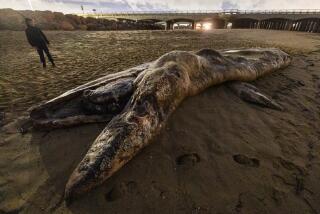Fossil Could Aid Whale Study
A well-preserved fossil skull found on an island off Santa Cruz, Calif., belongs to one of the smallest baleen whales ever known, and it could help explain why whales have such well-developed hearing, scientists said.
The skull and other parts of the small whale, believed to be 12 million to 14 million years old and possibly related to modern toothless whales, were found embedded in a sandstone bluff on Ano Nuevo Island, about 19 miles northwest of Santa Cruz.
The 35-pound skull is a “beautiful specimen,” said Kenneth S. Norris, a professor of natural history at UC Santa Cruz. It was found in May by a UC Santa Cruz graduate student who spotted it as an irregularity in a rock formation while studying elephant seals.
Norris said it is unusual to find a cetacean skull with the delicate ear bones intact. Those tiny bones could help researchers learn how whales and other marine mammals developed their exceptionally acute hearing, he said.
The animal itself, 15 feet long and weighing about 1,500 pounds, apparently was an adult pygmy baleen whale “with close linkage to the modern California gray whale,” Norris said. California grays can be as long as 40 feet and weigh 40 tons.
More to Read
Sign up for Essential California
The most important California stories and recommendations in your inbox every morning.
You may occasionally receive promotional content from the Los Angeles Times.








